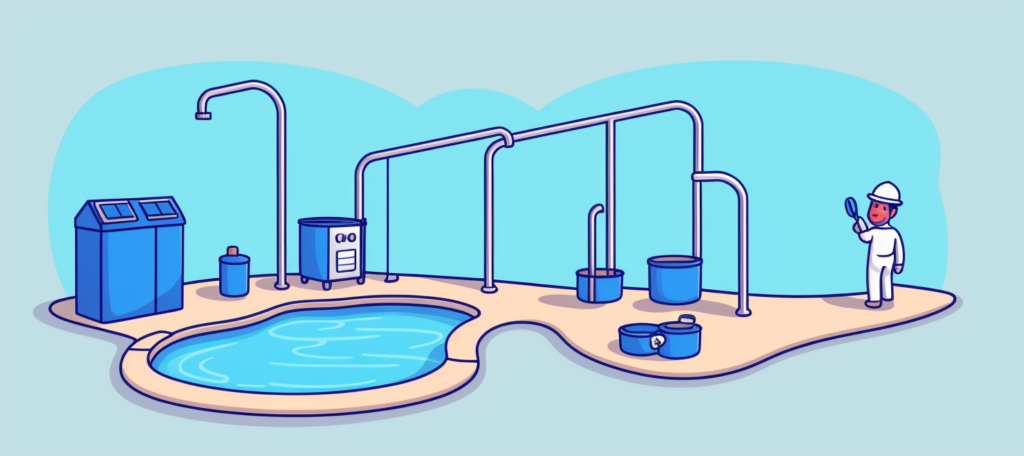Think of your pool as a gigantic solar energy sponge, absorbing sunlight much like plants engage in photosynthesis. As a pool owner, you have the luxury of a personal oasis during the sweltering summer months, but maintaining a pool isn’t without challenges. Particularly, maintaining a comfortable water temperature for an extended swimming season can put a dent in your wallet. But what if you could turn the tables and let the sun work for you? Solar pool heaters could be your perfect solution. Not only could these save you a considerable amount of money, but they could also expand your swimming season from the early warmth of spring to the cool beginnings of autumn.
Much like a sunflower tracking the sun, solar pool heaters capture the sun’s thermal energy to warm your pool water. These heaters are akin to solar photovoltaic (PV) panels, but they come with an added twist: water heating. They work by pumping pool water through solar collectors, usually mounted on your rooftop, where the water absorbs the heat before it is returned to your pool. The beauty of solar pool heaters? They can significantly cut your pool heating costs. Not only are they environmentally friendly, but they also help save you money by reducing your reliance on costly fuels. The potential savings from switching to a solar pool heater depend on a variety of factors, such as your pool’s current heating source, the efficiency of your system, the initial cost, and other conditions.
Solar pool heaters are a remarkable application of renewable energy, utilizing the inexhaustible and freely available solar power. It’s an efficient process involving several key components working in harmony. Firstly, a solar collector serves as the primary device for heating. This component functions much like a large solar panel, but instead of converting sunlight into electricity, it absorbs sunlight to heat the pool water that circulates through it. Prior to the water entering the solar collector, it passes through a filter that removes any debris, ensuring the water is clean and won’t compromise the system’s functionality or efficiency. Following filtration, a pump propels the water through the system, circulating it from the pool, through the filter and solar collector, and then back into the pool. Lastly, a crucial part of this circulation process is guided by a flow control valve, which can be either manual or automatic. This device’s purpose is to channel pool water through the solar collector at the optimal times for heating. Together, these components not only warm up your pool, but they also manifest a commitment to a greener and more sustainable lifestyle.
Solar pool heaters work on a very simple principle. When your pool’s temperature drops below the desired level, a temperature sensor sends a signal to a controller. This controller then powers up a pump, which circulates water from your pool through a series of solar collectors mounted on a nearby surface such as a roof or a rack. As the water flows through these solar collectors, it gets heated by the absorbed solar energy and is then returned back to the pool.
A properly configured solar pool heating system will automatically manage this flow of water, ensuring your pool maintains a comfortable temperature throughout the day. Solar pool heaters are extremely efficient in climates that get a good amount of sunlight during the swimming season.
Solar pool heating systems primarily rely on two types of solar thermal collectors: glazed and unglazed. The choice between the two comes down to your particular needs, climatic conditions, and budget.
Glazed solar collectors, also referred to as flat-plate solar collectors, are the more sophisticated variety. These collectors feature a robust construction that involves copper tubing set on an aluminum plate, all encased within an iron-tempered glass covering. This design facilitates higher efficiency in heating water and requires less space, enabling them to deliver higher levels of heat. Given their construction, glazed solar collectors are apt for year-round use, making them particularly suitable for colder climates. However, this enhanced performance and versatility come at a higher cost compared to unglazed solar collectors.
On the other hand, unglazed solar collectors are the simpler, more affordable option. These collectors typically comprise heavy-duty rubber or black plastic materials, which are treated with ultraviolet (UV) light to increase their lifespan. Although they may not provide the same level of efficiency as their glazed counterparts, unglazed solar collectors still make an excellent choice for warmer climates where pool temperatures do not drop below freezing.
In essence, the choice between glazed and unglazed solar collectors is akin to choosing between a high-performance sports car and a reliable all-terrain vehicle. Both can get the job done, but the best choice for you depends on your specific needs and circumstances.

Installing a solar pool heater does require an upfront investment, with the Department of Energy indicating costs typically ranging from $2,500 to $4,000. These costs account for the necessary materials, including the solar collector, filter, pump, and flow control valve, as well as labor and any necessary modifications to your roof or the surrounding area.
However, it’s important to understand that this initial investment should be considered in the context of future savings. The exact payback period will depend on several factors such as the amount of sunlight your location receives, how often you use your pool, and local energy costs. Generally speaking, however, many homeowners find that they recover their initial investment in 1 to 7 years. This is largely due to the considerable savings on energy bills, as using a solar heater to warm your pool replaces the need to use gas or electricity for the same purpose.
After the initial installation, the operating and maintenance costs of solar pool heaters are impressively low. In many cases, you could expect to spend virtually nothing in a year, provided there is no need for part replacement or repair. High-quality solar pool heaters, when properly installed, are remarkably durable, often operating efficiently for a span of 10 to 20 years.
Furthermore, apart from the financial aspect, opting for solar pool heaters also brings considerable environmental benefits. Unlike traditional gas or electric heaters, solar pool heaters use renewable energy, which reduces your carbon footprint and contributes to a more sustainable planet. Consequently, the value of solar pool heaters extends far beyond monetary savings, offering both environmental and lifestyle benefits.
Remember, while these figures provide a good ballpark estimate, the actual costs may vary depending on specific circumstances such as local installation costs, the size of your pool, and your specific heating needs. It’s always a good idea to obtain multiple quotes and consider all factors before making a decision.
Solar pool heaters are known for their low operational costs since they harness freely available solar energy. However, certain additional expenses may arise in relation to your solar pool heater.
It’s important to factor in these potential costs when considering a solar pool heater to gain a complete understanding of the investment.

Selecting a solar pool heater requires careful consideration of various factors. The cost, effectiveness, and lifespan of a solar pool heater will significantly depend on your local fuel costs, solar resource availability, and other factors. Therefore, it’s essential to understand and evaluate these factors to select the right solar pool heater that suits your needs.
The performance and efficiency of a solar pool heater are highly dependent on the solar energy your site can harness. Solar pool heaters utilize both direct and diffuse solar radiation, which means you don’t necessarily have to live in an extremely sunny region for a solar pool heater to be effective. If your location has unobstructed access to sunlight and primarily faces the south, it is likely suitable for a solar pool heating system. Consult with a solar system supplier or installer to conduct a thorough solar site analysis for your location.
Sizing a solar pool heater involves several elements, including the size of your pool, the length of the swimming season, average regional temperatures, your desired pool temperature, your site’s solar resource, collector orientation, tilt, and efficiency, and whether or not you use a pool cover. Generally, the surface area of your solar collector should be about 50% to 100% of the pool’s surface area. Cooler or cloudier regions might require an increased collector to pool surface area ratio to boost system efficiency.
If your pool size is 10×20 feet, for example, it equates to a total pool surface area of 200 square feet. In this case, the solar collector size required would fall between 100 square feet at the low end (equivalent to 50% of the pool’s surface area), and 200 square feet at the high end (matching 100% of the pool’s surface area).
As a rule of thumb, a larger collector surface area can extend the swimming season. For instance, a pool in Florida might require a solar collector that equals 100% of the pool’s surface area for year-round use. On the other hand, in northern California, where pools are typically used for 6-8 months of the year, a collector surface area equivalent to 60%–70% of the pool’s surface area is generally sufficient.
Keep in mind that the use of a pool cover can help reduce the required collector area. Additionally, if you’re planning to switch from a conventional pool heating system to a solar system, you might need to adjust your pool pump size to ensure efficient water circulation through the collectors.
The location, orientation, and tilt of the solar collectors can impact the overall performance of your solar pool heating system. Ideally, solar pool heater collectors should face true south in the northern hemisphere to maximize daily and seasonal solar energy. However, it is worth noting that even with a deviation of up to 45º east or west of true south, the performance drop is usually insignificant.
Consider factors like roof orientation, landscape features that could cause shading, and local weather conditions when determining the optimal orientation. The collector’s tilt angle is another important factor and can vary based on your latitude and the length of your swimming season. For a summer-only heating system, the collector’s tilt should ideally be equivalent to your latitude minus 10º–15º. For year-round heating, the collector should be tilted at an angle equal to your latitude. However, even if the collector isn’t tilted at the optimum angle, it doesn’t typically result in a significant reduction in system performance. Therefore, collectors can often be installed flat on your roof, which may be more aesthetically pleasing, even if it’s not the optimum angle. After assessing these factors, you’ll be ready to compare system costs and look into local codes, covenants, and regulations that might influence your installation. Selecting the right solar pool heater for your home is an investment that, with careful planning and consideration, can lead to long-term financial and environmental benefits.

When looking to purchase a solar pool heater, it is crucial to consider various options available in the market. Each brand offers unique features, pros, and cons that may fit different user needs. According to todayshomeowner.com, here are some noteworthy options:
When selecting a solar pool heater, consider your specific needs, pool type, budget, and the heater’s efficiency, warranty, and build quality.
Solar pool heaters are a sustainable, cost-effective, and efficient solution for warming your pool and extending your swimming season. From an array of quality products offered by different manufacturers, each with its unique features and capabilities, you can select the heater that best aligns with your specific needs and preferences. While the initial investment may seem substantial, remember that the operational costs are minimal. Solar pool heaters utilize free solar energy, making them eco-friendly and cost-effective in the long run. Moreover, with the majority of these heaters being low maintenance, the costs for upkeep are relatively small. So, if you’re in search of a pool heating solution that’s environmentally friendly, energy-efficient, and capable of delivering a pleasant, warm pool experience, solar pool heaters are a compelling choice to consider. By integrating such an innovative and eco-conscious solution, you’re not only making a great choice for your home, but also contributing to a greener and more sustainable future.
Yes, solar pool heaters can be used in cold climes; but, in areas with low sunlight or very cold temperatures, they may be less efficient.
The temperature rise of a solar pool heater is affected by a number of parameters, including the system’s size, the amount of sunlight, and the air temperature. Solar pool heaters, on the other hand, can normally raise the temperature of pool water by 5 to 15 degrees Fahrenheit.
Stay a while and read more posts like this
In recent years, Europe has witnessed a remarkable surge in the adoption of solar panels, marking a pivotal shift towards renewable energy. Data from the...
Renewable Energy, Solar Energy, Solar Energy Basics, Solar Technology
“Unlock the Truth: Get the Facts on Solar Energy!” Introduction Solar energy is becoming increasingly popular as a renewable energy source, but there are...
Imagine a world where you’re able to cut your monthly energy expenditure substantially. A reality where your home isn’t reliant on finite,...